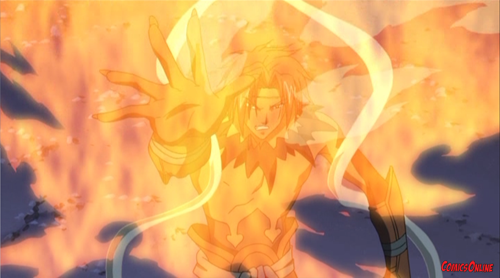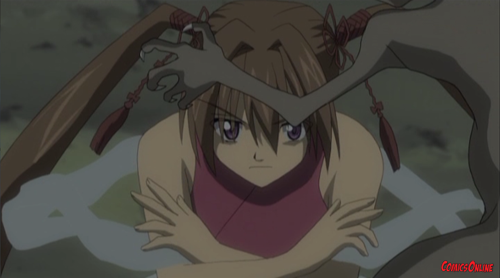
Shonen Onmyouji is a shonen historical action/comedy with some romantic subplots set during Japan's Heian period (the classical era just prior to the beginning of the feudal era). Abe no Masahiro, a kind prodigy and grandson of the great omnyouji Abe no Semei, has been taught by his grandfather the ways of the omnyouji. However, Abe doesn't want to become an omnyouji at first because he has had his sixth sense sight, the ability to see spirits, sealed – unbeknownst to him – for his own protection. After encountering a strange creature who is actually one of the fabled twelve Shikigami (deities created by humans), who he dubs Mokkun, Abe begins to work diligently to become his grandfather's successor. As the series progresses he must overcome foreign demons from China and an enemy from his grandfather's path who wants to break the bonds between this world and the netherworld.

Highlights:
Shonen Onmyouji, as mentioned, is set during Japan's Heian period. While the piece doesn't require knowledge of the period or Shintoism specifically it does help with immersion. Several aspects of the anime will be more understandable, such as the style of dress, the spells they use, references to China, the structure of imperial court, various features of Shinto, and other details. For those who don't know about them, these aspects do not dominate the anime, with the exception of the spells, and for the latter the knowledge isn't necessary for understanding their purpose. The setting was likely chosen as a high point in Japanese culture as well as the point where the warrior class was still not in prominence.
For those who are interested, this period is a high point for Japanese culture. It marks the movement of the capital to Kyoto, where it would remain for the next millennium until it was moved to its present location in Tokyo. It also marked two aspects many associate with feudal Japan: the rise of the samurai; and the introduction and spread of early forms of Buddhism and Confucianism. As such, Shonen Onmyouji appears to take place during the early part of the Heian period due to a lack of samurai's political power and prominence of traditional Shinto rituals with only some Buddhist influences. China is virtually unknown, at least the onmyouji who are well learned. It is referenced as the region last known as Tang (countries in Asia historically are referred to by their dynasty names).

Overview:
I have to say I personally enjoy the historical Japanese pieces in general so going into this I was already hoping to enjoy it more on that basis and it didn't disappoint me. While Shonen Onmyouji doesn't do anything special beyond its setting, what it does, it generally does well. It tells the story of a young boy (that's what shonen literally means) growing up.
Shonen Onmyouji is basically divided into two main arcs. The first deals with foreign demons from China who come over after their leader, a winged tiger, was seriously wounded. The leader wants to abosrb the life of beings with powerful spiritual energy, including Abe and Fujiwara no Akiko, a kind-hearted imperial princess Abe falls in love with. The first arc appears to be at times almost xenophobic in nature. The foreign demons are portrayed as typical evil entities while the Japanese demons are all sympathetic comic relief characters. The one exception is a misguided princess which the narrative makes sympathetic. The constant use of “foreign demon” and their powerful and evil portrayal versus the almost cute and friendly local demons really emphasizes the xenophobic undertones of the arc. While its true that Japan, being an island nation, was somewhat more suspicious of outsiders historically, the narrative seems to portray a much more closed society than existed during this period.

The second arc deals with the return of Chishiki no Soushu, archenemy of Seimei, who has transferred himself into the body of Seimei's departed friend. Soushu wants to open the gates between the netherworld and Japan and reign over it. This arc is a complete reversal. Here the villian is home grown and is not even a demon, but a human. This arc is a way of showing how mankind is far worse than many demons. Whereas the foreign demon wanted to kill those who had powerful spiritual energy to heal its wounds and give it power and was content to leave the rest of the populace alone (assuming they did likewise), Soushu wants death on a massive scale with his indiscriminate carnage and chaos.
If there is one main thing I must complain about this anime, it is the ending. The anime, like many other works, has a cop-out feel-good ending, although not completely. This trope is not only overused, it also weakens a good story. Instead of taking a narrative to its natural conclusion, people force an artificial one to make people feel happy and that really ruins it. While I understand the story wasn't finished here, since Abe had yet to surpass his grandfather (which was the central crux of the story) the lack of any significant sacrifices on the part of the heroes after such build-up just feels anti-climactic.

In spite of my distate for the ending, Shonen Onmyouji is still a great historical action/comedy. Even those unfamiliar with Heian period can fully enjoy Shonen Onmyouji.
ComicsOnline gives Shonen Onmyouji 4 out of 5 Shikigami gods.




